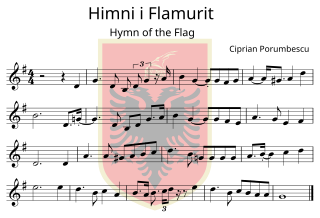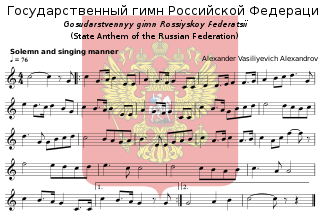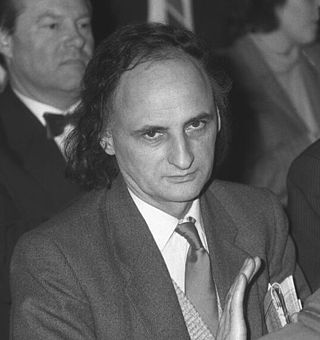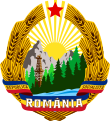An anthem is a musical composition of celebration, usually used as a symbol for a distinct group, particularly the national anthems of countries. Originally, and in music theory and religious contexts, it also refers more particularly to short sacred choral work and still more particularly to a specific form of liturgical music. In this sense, its use began c. 1550 in English-speaking churches; it uses English language words, in contrast to the originally Roman Catholic 'motet' which sets a Latin text.

The national flag of Romania is a tricolour featuring three equal vertical bands colored blue, yellow and red, with a width to length ratio of 2:3.

"Deșteaptă-te, române!" is the national anthem of Romania. It originated from a poem written during the Wallachian Revolution of 1848.

"Himni i Flamurit" is the national anthem of Albania, adopted in 1912. Its music is derived from the Romanian patriotic song "Pe-al nostru steag e scris Unire", composed by Ciprian Porumbescu. The lyrics, was written by Albanian poet Asdreni. The anthem was originally titled "Betimi mbi Flamur".

"Limba noastră", known in English as "Our Language", is the national anthem of Moldova. It has been used since 1994 and was officially adopted on 22 July 1995.

Ciprian Porumbescu was a Romanian composer born in Șipotele Sucevei in Bucovina. He was among the most celebrated Romanian composers of his time; his popular works include Crai nou, Song of the Tricolour, Song for Spring, Ballad for violin and piano, and Serenada. In addition, he composed the music for the Romanian patriotic "Song of Unity", also known as "Pe-al nostru steag e scris Unire", which was Romania's anthem from 1975 to 1977 and is currently used for Albania's national anthem, "Himni i Flamurit". His work spreads over various forms and musical genres, but the majority of his work is choral and operetta.

The "State Anthem of the Russian Federation" is the national anthem of Russia. It uses the same melody as the "State Anthem of the Union of Soviet Socialist Republics", composed by Alexander Alexandrov, and new lyrics by Sergey Mikhalkov, who had collaborated with Gabriel El-Registan on the original anthem. From 1944, that earliest version replaced "The Internationale" as a new, more Soviet-centric and Russia-centric Soviet anthem. The same melody, but without any lyrics, was used after 1956. A second version of the lyrics was written by Mikhalkov in 1970 and adopted in 1977, placing less emphasis on World War II and more on the victory of communism, and without mentioning Joseph Stalin by name.

The State Anthem of the Union of Soviet Socialist Republics was the national anthem of the Soviet Union and the regional anthem of the Russian Soviet Federative Socialist Republic from 1944 to 1991, replacing "The Internationale". Its original lyrics were written by Sergey Mikhalkov (1913–2009) in collaboration with El-Registan (1899–1945), and its music was composed by Alexander Alexandrov (1883–1946). For a two-decade interval following de-Stalinization, the anthem was performed without lyrics. The second set of lyrics, also written by Mikhalkov and in which Stalin's name was omitted, was adopted in 1977.

Televiziunea Română, more commonly referred to as TVR, is the short name for Societatea Română de Televiziune, the Romanian public television. It operates nine channels: TVR 1, TVR 2, TVR 3, TVR Cultural, TVR Folclor, TVR Info, TVRi, TVR Moldova and TVR Sport along with six regional studios in Bucharest, Cluj-Napoca, Iași, Timișoara, Craiova, and Târgu Mureș.

The State Anthem of the Moldavian Soviet Socialist Republic was the anthem of Moldova whem it was a constituent republic of the Soviet Union. Adopted in 1945, the music was composed by the composer Ștefan Neaga, and the original lyrics were written by the poets Emilian Bukov and Bogdan Istru.

Andrei Mureșanu was a Romanian poet and revolutionary of Transylvania.
Revolutionary songs are political songs that advocate or praise revolutions. They are used to boost morale, as well as for political propaganda or agitation. Amongst the most well-known revolutionary songs are "La Marseillaise" and "The Internationale". Many protest songs can be considered revolutionary - or later become canonized as revolutionary songs following a successful revolution. On the other hand, once a revolution is established, some of the aspects of protest song may be considered counter-revolutionary.
"Te slăvim, Românie" was the national anthem of the Romanian People's Republic, and later Socialist Republic of Romania between 1953 and 1975. The lyrics were written by Eugen Frunză and Dan Deșliu, the music by Matei Socor. It mentions Romania's brotherhood with the Soviet Union and praises Leninist ideology.

Grigore Vieru was a Moldovan poet, writer and unionist advocate, known for his poems and books for children. His poetry is characterized by vivid natural scenery, patriotism, as well as a venerated image of the sacred mother. Vieru wrote in the Romanian language. In 1993 he was elected a correspondent member of the Romanian Academy.

The colors of the national flag of Romania has a long history, though the association of the three colors only dates to the 18th century. Red, yellow and blue were found on late 16th-century royal grants of Michael the Brave, as well as shields and banners. Thus, the late 13th century Wijnbergen armorial shows the coat of arms of the Wallachian ruler Litovoi as consisting of a shield of ten vertically alternating gold-and-red bands. The same two colors, gules and or, also appeared on the late 15th century flag and coat of arms of Moldavia, during the reign of Stephen the Great. Then, from the late 16th century until the mid-17th century, the historical coat of arms of Transylvania gradually developed as a shield party per fess, consisting of a black eagle on blue background in the upper field, a dividing red band in the middle, and seven red towers on golden background in the lower field. Finally, in the last quarter of the 18th century, Bukovina gets its own coat of arms from the Habsburg Empire, a blue-and-red shield party per pale with a black aurochs' head in the middle, and three golden six-pointed stars surrounding it. During the Wallachian uprising of 1821, these three colors were present, along others, on the canvas of the revolutionaries' flag and its fringes; for the first time a meaning was attributed to them: "Liberty (blue-sky), Justice, Fraternity ( blood)".
Events from the year 1917 in Romania.
"Pe-al nostru steag e scris Unire" is a Romanian patriotic song dedicated to the United Principalities of Moldavia and Wallachia established in 1859. The text was written by Andrei Bârseanu and the music was composed by Ciprian Porumbescu in 1880. Its tune is now used in the Albanian national anthem. The anthem of the Dutch city of Maastricht bears considerable similarity to it, though it is unknown if Guus Olterdissen or his brother, Alfons, knew the tune.
"Treceți, batalioane române, Carpații" is a Romanian patriotic song. It is thought to have been composed in 1916, shortly before Romania's entry into World War I, although its first historical apparition occurred in February 1919, when members of the Romanian Legion of Transylvanian–Bukovinian Volunteers were recorded singing a version of the song. The original version is about how Romanian soldiers say goodbye to their families and go to Transylvania to fight against the Austro-Hungarian Empire for the unification of the region with the Kingdom of Romania.
"Marș triumfal", or "Marș triumfal și primirea steagului și a Măriei Sale Prințul Domnitor" by its long name, was the first anthem of Romania. It is a piece without lyrics composed by Eduard Hübsch. In 1861, a contest was organized to decide the national anthem of the country with a prize of 100 golden coins. Hübsch was the winner, and the march was officially adopted on 22 January 1862.
Events from the year 1987 in the Socialist Republic of Romania.













